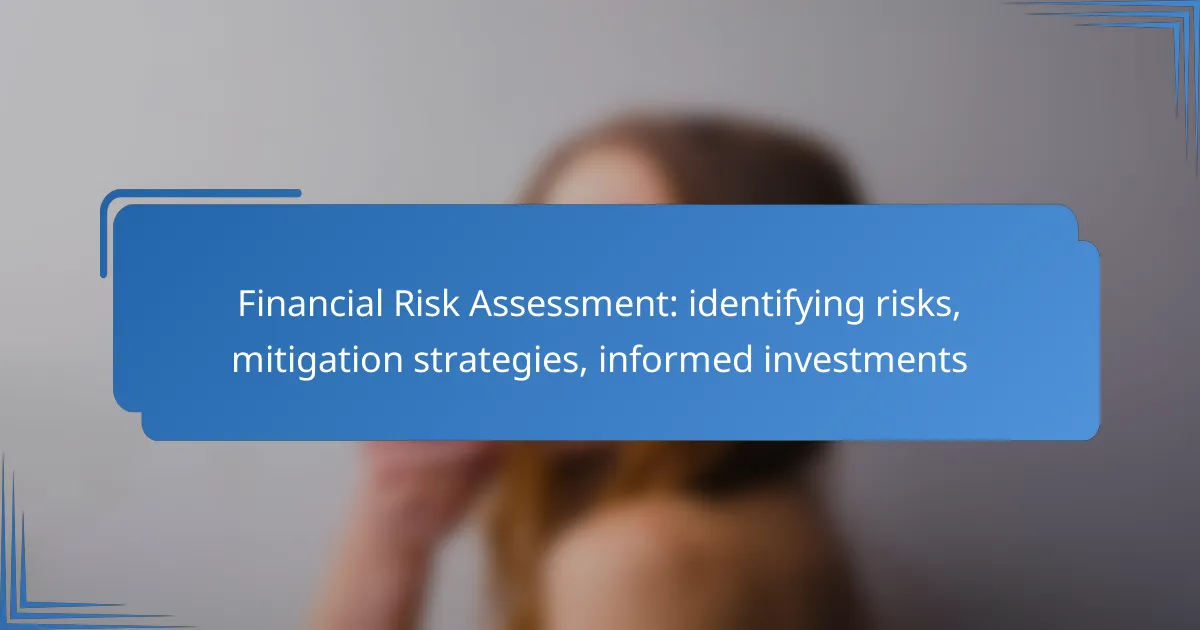Financial risk assessment is essential for identifying potential vulnerabilities that can impact an organization’s financial health. By systematically analyzing various factors, investors can implement effective mitigation strategies to minimize losses and make informed investment decisions. Understanding key risks such as market volatility and credit risk allows for proactive management and enhanced financial stability.

What are the key financial risks in Australia?
In Australia, key financial risks include market volatility, credit risk, liquidity risk, operational risk, and regulatory risk. Understanding these risks is crucial for making informed investment decisions and implementing effective risk mitigation strategies.
Market volatility
Market volatility refers to the fluctuations in asset prices due to various factors such as economic changes, political events, or market sentiment. In Australia, investors should be aware that significant market shifts can occur rapidly, impacting investment portfolios.
To manage market volatility, consider diversifying investments across different asset classes and sectors. Using hedging strategies, such as options or futures, can also help mitigate potential losses during turbulent market conditions.
Credit risk
Credit risk is the possibility that a borrower will default on their financial obligations. In Australia, this risk is particularly relevant for lenders and investors in corporate bonds or loans.
To assess credit risk, evaluate the credit ratings of borrowers and consider their financial health. Implementing strict credit assessments and monitoring borrower performance can help minimize exposure to defaults.
Liquidity risk
Liquidity risk arises when an asset cannot be quickly sold or converted into cash without significantly affecting its price. In the Australian market, certain investments, like real estate or small-cap stocks, may present higher liquidity risks.
Investors can mitigate liquidity risk by maintaining a portion of their portfolio in highly liquid assets, such as cash or government bonds. Regularly reviewing the liquidity of investments can also help ensure that funds are available when needed.
Operational risk
Operational risk involves potential losses resulting from inadequate or failed internal processes, people, or systems. In Australia, businesses must be vigilant about operational risks, especially in sectors like finance and technology.
To reduce operational risk, implement robust internal controls, conduct regular audits, and invest in employee training. Establishing a risk management framework can also help identify and address potential operational vulnerabilities.
Regulatory risk
Regulatory risk refers to the potential for changes in laws or regulations that could negatively impact an investment or business operation. In Australia, compliance with financial regulations is crucial for maintaining market integrity.
Stay informed about regulatory changes by regularly reviewing updates from the Australian Securities and Investments Commission (ASIC) and other relevant authorities. Engaging with legal and compliance experts can also help navigate complex regulatory environments and minimize risks.

How can financial risks be identified?
Financial risks can be identified through systematic analysis and evaluation of various factors that may impact an organization’s financial health. This involves utilizing frameworks, data analysis techniques, and scenario analysis to pinpoint potential vulnerabilities.
Risk assessment frameworks
Risk assessment frameworks provide structured approaches to identify and evaluate financial risks. Common frameworks include the COSO ERM Framework and ISO 31000, which guide organizations in establishing risk management processes and controls.
When using these frameworks, organizations should consider their specific context, including industry regulations and internal policies. Regular reviews and updates to the framework are essential to adapt to changing risk landscapes.
Data analysis techniques
Data analysis techniques play a crucial role in identifying financial risks by leveraging quantitative data to reveal patterns and anomalies. Techniques such as regression analysis, variance analysis, and predictive modeling can help forecast potential risks based on historical data.
Organizations should ensure they have access to high-quality data and employ skilled analysts to interpret the findings effectively. Regular data audits can help maintain data integrity and improve risk identification efforts.
Scenario analysis
Scenario analysis involves evaluating the impact of various hypothetical situations on an organization’s financial performance. By modeling different scenarios, such as economic downturns or regulatory changes, organizations can better understand potential risks and their implications.
It is beneficial to create a range of scenarios, from best-case to worst-case, to prepare for various outcomes. Engaging stakeholders in the scenario development process can enhance the relevance and accuracy of the analysis.

What are effective risk mitigation strategies?
Effective risk mitigation strategies are approaches designed to minimize potential financial losses by identifying and addressing risks proactively. These strategies can involve diversifying investments, utilizing insurance products, implementing hedging techniques, and conducting regular audits.
Diversification of investments
Diversification involves spreading investments across various asset classes, sectors, or geographic regions to reduce exposure to any single risk. By not putting all funds into one type of investment, you can lower the impact of poor performance in any one area.
A common rule of thumb is to hold a mix of stocks, bonds, and alternative assets. For instance, an investor might allocate 60% to equities, 30% to fixed income, and 10% to real estate or commodities. This balance can help stabilize returns over time.
Insurance products
Insurance products serve as a safety net against specific risks, providing financial compensation in the event of a loss. Common types include property insurance, liability insurance, and life insurance, each tailored to protect against different financial exposures.
When considering insurance, evaluate the coverage limits and deductibles to ensure they align with your risk tolerance and financial situation. For example, a business might opt for liability insurance to protect against lawsuits, which can be costly and unpredictable.
Hedging strategies
Hedging strategies involve using financial instruments to offset potential losses in investments. This can include options, futures, or other derivatives that provide a counterbalance to market fluctuations.
For instance, an investor holding a stock might purchase put options to sell the stock at a predetermined price, thus limiting potential losses. However, it’s essential to understand the costs associated with hedging, as they can reduce overall returns if not managed properly.
Regular audits
Regular audits are essential for identifying and assessing risks within an organization or investment portfolio. By systematically reviewing financial records, processes, and compliance with regulations, businesses can uncover vulnerabilities that may lead to financial loss.
Conducting audits at least annually can help ensure that risk management strategies remain effective and relevant. It’s advisable to engage external auditors for an unbiased perspective, which can provide valuable insights into areas needing improvement.

How does financial risk assessment impact investment decisions?
Financial risk assessment significantly influences investment decisions by identifying potential risks and enabling investors to make informed choices. By evaluating risks, investors can develop strategies to mitigate them, ultimately leading to more secure and profitable investments.
Informed portfolio management
Informed portfolio management relies on understanding the risks associated with various assets. By assessing financial risks, investors can diversify their portfolios effectively, balancing high-risk and low-risk investments to achieve desired returns. Regularly reviewing risk profiles helps in adjusting asset allocations based on market conditions.
For example, an investor might allocate 60% of their portfolio to stocks and 40% to bonds, adjusting these percentages as market volatility changes. This proactive approach can enhance overall portfolio performance while minimizing potential losses.
Risk-adjusted returns
Risk-adjusted returns measure the profitability of an investment relative to its risk. Investors should focus on achieving returns that compensate adequately for the risks taken, often using metrics like the Sharpe ratio to evaluate performance. A higher ratio indicates a better risk-return balance.
For instance, if two investments yield similar returns, the one with lower volatility is generally more attractive. Investors should aim for strategies that enhance risk-adjusted returns, such as employing stop-loss orders or hedging techniques.
Long-term financial planning
Long-term financial planning is essential for aligning investment strategies with future goals while considering potential risks. A thorough risk assessment allows investors to forecast challenges and adjust their plans accordingly, ensuring they remain on track to meet objectives such as retirement or education funding.
Investors should regularly revisit their financial plans, especially after significant market changes or personal life events. This ongoing evaluation helps in adapting strategies to maintain a healthy investment trajectory, ensuring that risks do not derail long-term aspirations.

What tools are available for financial risk assessment?
Financial risk assessment tools help organizations identify, analyze, and mitigate potential risks in their financial operations. These tools range from software solutions to analytical frameworks that enhance decision-making and investment strategies.
Risk management software
Risk management software provides a structured approach to identifying and mitigating financial risks. These platforms often include features for risk assessment, monitoring, and reporting, allowing businesses to track their exposure to various financial threats.
When selecting risk management software, consider factors such as user-friendliness, integration capabilities with existing systems, and compliance with relevant regulations. Popular options include platforms like RiskWatch and LogicManager, which cater to different business sizes and needs.
Financial modeling tools
Financial modeling tools enable users to create representations of a company’s financial performance under various scenarios. These models help assess potential risks by simulating changes in market conditions, interest rates, or operational costs.
Common tools include Excel-based models and specialized software like Quantrix or Adaptive Insights. It’s crucial to ensure that the models are flexible and can be easily updated to reflect real-time data for accurate risk assessment.
Data visualization platforms
Data visualization platforms transform complex financial data into intuitive visual formats, making it easier to identify trends and risks. These tools help stakeholders quickly grasp potential issues by presenting data in charts, graphs, and dashboards.
Examples of popular data visualization tools include Tableau and Power BI. When using these platforms, focus on key performance indicators (KPIs) relevant to your financial risks, and ensure that the visuals are clear and actionable for decision-makers.
